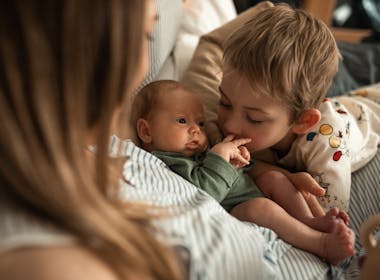In a previous article, we looked at the why behind hookup culture’s destructive impact on college-age women in particular, and took a closer look at the double standard that exists in the average man’s preferences for the type of woman he finds attractive when he’s pursuing a hookup, versus when he’s looking for a long-term marriage partner. We examined how anatomical and hormonal differences between men and women’s brains can contribute to mismatched approaches to sex, especially when it comes to approval of casual sex, opinions on an acceptable number of premarital sexual partners, and beliefs about whether emotional involvement is required for sexual intercourse to occur [1]. (Take a guess which sex did not prioritize emotional involvement in order for sexual intercourse to take place!)
Women’s natural preference for committed relationships over hookups makes sense, considering that most women have more sexual enjoyment and experience orgasms more regularly within committed relationships [2]. Ironically, both men and women question women’s (but not men’s) entitlement to pleasure during hookups, but believe highly in women’s (as well as men’s) right to pleasure inside committed relationships. In other words, men tend to give more attention to helping their female partner achieve orgasm if they’re in a committed relationship with them. In view of these clear differences between males and females, it is no surprise there is a great deal of sexual conflict between men and women.
How else do men and women display different sexual preferences?
Women put much more emphasis on committed relationships as the proper context for sex than men, and women are more prone to modifying their sexual behavior in response to social conditions [3]. Research also suggests that men are generally more inclined and willing to use aggression to get sex than women are [4]. This can entail being more emotionally and verbally aggressive, as well as physically. When sexual assault or rape occurs, it is man-on-woman (as opposed to woman-on-man) the vast majority of the time. One reason for this is that it is far easier for men who, on average, have 80% more muscle fiber in their upper bodies and 50% more in their lower bodies than women, to physically overcome women.
Hookup culture in college is one result of the sexual revolution
In order to grasp the full scope of impact from pervasive hookup culture and general societal acceptance of promiscuity on young people’s well-being and ability to form meaningful relationships, we need to understand that before the sexual revolution, it wasn’t like this. Roughly 60 years ago, we had a whole different culture where young men and women were living lives much more in sync with women’s sexual natures (which include a natural preference for committed sexual relationships, as within marriage). Few children were born out-of-wedlock, divorce was rare, a much smaller percentage of households were run by single parents, and the vast majority of Americans were married by age 30. Times have indeed changed.
Then and now: women used to be in the driver’s seat regarding when sex was introduced into a relationship
What were they doing differently 60 years ago? Generally, women demanded love, romance, and commitment before agreeing to sex—usually this meant saving sex for marriage. Before the sexual revolution, a male had to at least act like he was in love if he expected a woman to be sexually involved with him. In hookup culture, this is no longer the case. The sexual revolution, then, has changed our sexual culture from one that most women prefer, to one that many men prefer.
The college-age women whom I have spoken with about these matters acknowledge that they don’t like being promiscuous [5]. However, they feel like if they don’t “put out,” they’ll be outcompeted by the more sexually adventurous women among them, i.e., that another girl will end up in a relationship with the guy in whom they are interested. What most of these women don’t know, however, is that recent research shows the opposite to be true—at least when it comes to true love and lasting relationships.
How men fall in love differently than women
From a hormonal perspective, men and women actually fall in love quite differently. In contrast to the complicated interplay of hormones that makes for the female cycle, women have a simpler and more direct hormonal system when it comes to falling in love. When females have sex, dopamine—the biochemical common to all addictions—rises rapidly, and the strong bonding biochemical oxytocin also spikes. This can make a woman bond very quickly and profoundly during sexual encounters with a man, especially if she has an orgasm, after which oxytocin levels erupt and peak.
According to “The Love Biologist,” Dawn Maslar, men’s falling-in-love biochemistry is much more complex, complicated, and prone to failure, because they go through a two-stage bonding process which requires a delay in sexual gratification to activate properly. When sexually aroused, males’ dopamine and testosterone levels spike, while vasopressin—the main male bonding hormone, whose chemical structure is very close to oxytocin— rises at a slower rate, i.e., over time, and not simply within the narrow time limit of a single sexual encounter [6]. If the sexual event leads to orgasm, the resulting cascade of serotonin, oxytocin, and especially endorphins cancels and nullifies vasopressin’s bonding effects.
This is why, on average, a man is much more able than a woman is to have “no strings attached” sex (and why, as I mentioned in my previous article, men with high numbers of sexual partners are more likely to experience a decrease in their rating of a woman’s physical and sexual attractiveness after having sex with her).
But if a woman demands romance and commitment over a period of time before agreeing to sex, the consistent presence of vasopressin released during their interactions gradually leads her male partner’s brain to build new receptors. At some point thereafter, the vasopressin molecules lock into these receptors, which we can say is the male partner entering the first stage of falling in love.
Interestingly, testosterone levels will drop in the second stage of male bonding [7]. And, without the usual high levels of testosterone (which would normally interfere with the natural rise of oxytocin), oxytocin has greater effects in his body. A second stage of the bond is then formed. Crucially, women (and especially young, single women) need to realize the superpower they have in making men wait for sex.
Hooking up is a losing game, but real love is a winning game
Rather than freeing college-age women, our hypersexualized hookup culture has enslaved them to a cultural script that is profoundly unfulfilling and leads instead to higher levels of depression and anxiety. One indicator of this might be the correlation between acceptance of the tenets of the sexual revolution (including hookup culture), and declining levels of women’s happiness since the mid-1970s. In contrast, the tried-and-true practice of women enforcing monogamy and premarital chastity has a scientifically-based rationale.
In other words, women should be empowered to use the “superpower” they have to make men wait for sex, as the ones who are willing to wait are the ones looking for more than just their next hookup.
References:
[1] Carroll, J L et al. “Differences between males and females in motives for engaging in sexual intercourse.” Archives of sexual behavior vol. 14,2 (1985): 131-9. doi:10.1007/BF01541658 [2] Taylor, Shelley E et al. “Are plasma oxytocin in women and plasma vasopressin in men biomarkers of distressed pair-bond relationships?.” Psychological science vol. 21,1 (2010): 3-7. doi:10.1177/0956797609356507 [3] Baumeister, R F. “Gender differences in erotic plasticity: the female sex drive as socially flexible and responsive.” Psychological bulletin vol. 126,3 (2000): 347-74; discussion 385-9. doi:10.1037/0033-2909.126.3.347 [4] Peplau, LA. “Human sexuality: how do men and women differ?” Current Directions in Psychological Science, vol. 12, no. 2 (2003): pp. 37-40. [5] England P, Bearak J. “The sexual double standard and gender differences in attitudes toward casual sex among U.S. university students.” Demographic Research, vol. 30, art. 46 (2014): pp. 1327-38. DOI: 10.4054/DemRes.2014.30.46 [6] Armstrong, E. A., England, P., & Fogarty, A. C. K. (2012). Accounting for Women’s Orgasm and Sexual Enjoyment in College Hookups and Relationships. American Sociological Review, 77(3), 435–462. https://doi.org/10.1177/0003122412445802 [7] Burnham, T C et al. “Men in committed, romantic relationships have lower testosterone.” Hormones and behavior vol. 44,2 (2003): 119-22. doi:10.1016/s0018-506x(03)00125-9Additional Reading:
What’s happening in male vs. female brains during sex?
3 essential components of the female orgasm







